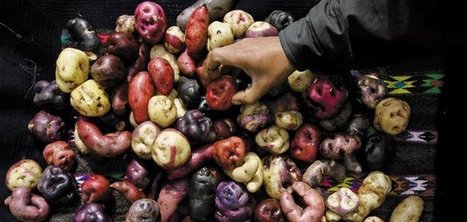Is limiting the use of the Arabic word for God a sign of growing intolerance towards minorities?
Get Started for FREE
Sign up with Facebook Sign up with X
I don't have a Facebook or a X account
 Your new post is loading... Your new post is loading...
 Your new post is loading... Your new post is loading...

Woodstock School's curator insight,
June 4, 2014 6:05 AM
A good teaching tool for explaining the diversity of languages. 
Chris Plummer's curator insight,
January 11, 2015 11:46 PM
Summary- This video explains how so many languages came to be and why. By the early existence of human there was a such smaller variety of languages. Tribes that spoke one language would often split in search of new recourses. Searching tribe would develop in many new different ways than the original tribe. new foods, land, and other elements created a radically different language than the original.
Insight- In unit 3 we study language as a big element of out chapter. One key question in chapter 6 was why are languages distributed the way they are. It is obvious from the video that languages are distributed they way they are is because of the breaking up from people which forced people to develop differently thus creating a different language. As this process continues, there become more and more branches of a language family.

Kevin Nguyen's curator insight,
October 7, 2015 1:17 PM
These vessels are specifically made to increase more profit and is a symbol of economic power for trades between Europe and Asia. They aim to increase containment of cargo so it is more efficient and time consuming of going back to fourth. However, they forced ports to become bigger to compete and keep up with these new inventions. These ships are getting too big and are only able to transit through the Suez canal and cannot go through the Panama. This lead to the Chinese expanding their reach to Nicaragua and building a larger canal to be able to pass through Central America. 
Alex Smiga's curator insight,
March 14, 2016 7:42 PM
These containers are symbols of global commerce that enable economies of scale to be profitable and the outsourcing of so many manufacturing jobs to developing countries. The invention of these containers have changed the geography of global shipping and the vast majority of the world's largest ports are now in East Asia. Today though, the biggest container ships are too big to go through the Panama Canal, encouraging China to build a larger canal through Nicaragua.
BrianCaldwell7's curator insight,
April 5, 2016 8:18 AM
These containers are symbols of global commerce that enable economies of scale to be profitable and the outsourcing of so many manufacturing jobs to developing countries. The invention of these containers have changed the geography of global shipping and the vast majority of the world's largest ports are now in East Asia. Today though, the biggest container ships are too big to go through the Panama Canal, encouraging China to build a larger canal through Nicaragua. Tags: transportation, globalization, diffusion, industry, economic. |

Amanda Morgan's curator insight,
September 18, 2014 10:51 AM
Great video! Very cool to see how far the world has come in regards to globalization. Technology has allowed the people across the globe to immerse themselves in other cultures and good from other parts of the world.

Kaitlin Young's curator insight,
December 13, 2014 12:57 PM
Potatoes are one of the most widespread foods in the world, due to its resiliency to harsh weather conditions and its ability to grow to large sizes. Potatoes can also be traced to show the beginning forces of globalization. Before modern communication and transportation technology, globalization occurred at a much slower rate. Globalization spread through trade routes in the forms of foods, resources, and therefore cultures and people.
BrianCaldwell7's curator insight,
March 16, 2016 3:52 PM
The Colombian Exchange is a term that describes the most dramatic biologic transfer in history. European explorers brought animals and agricultural items from the Old World to the New and subsequently brought back items from the New World back to the Old. This exchange profoundly reshaped many societies as agricultural diffusion of the potato lead to the changes across northern Europe.
Tags: agriculture, food production, diffusion, historical, colonialism, Europe. |














Yes !! The religion of love and peace, is not a religion, and sure that not a pacific love, just a bunch of hatred and criminals wich endanger the world, in the name of a pedophile crazy, Muhamad, and and inexisting allah, a Devil, not a God !! The Obama`s "Holly Curan ", a dirty instruction book for killing !!
Religion and politics are often effect each other in ways people can never imagine. Even in Western nations, were religion is separated from the state, religion still plays a major role in many political debates. This law banning the use of the word Allah by non- Muslim people in Malaysia is an extension of the political movement within Islam. Politics has been the major reason for the rise of the radical sect of Islam. It developed as reaction to the perceived westernizing of Muslim nations that was occurring in the 20th century. The Iranian revolution was a response to the westernizing polices of the Shah. It replaced a secular government with a theocratic one. ISIS main goal is to establish a caliphate i.e. a ruling empire. Throughout history, religion has been used as an excuse to build dynasties and gain more power. Politics in the true motivation behind much of this radicalization.